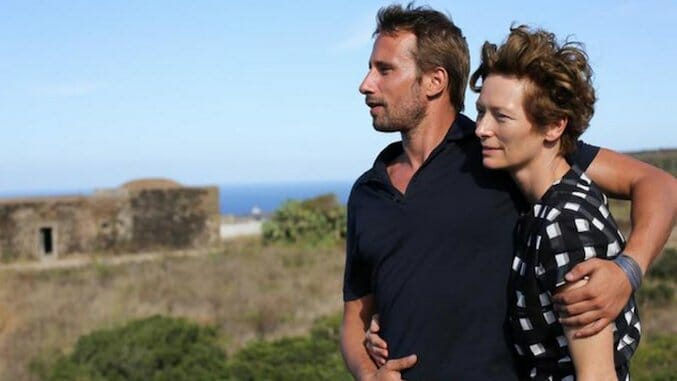
As a dramatist, playwright and screenwriter, Harold Pinter believed in the power of oblique dialogue and pregnant silences to reveal as much about characters and themes as direct exposition. Some of his most famous works—stage plays like The Homecoming and Betrayal and screenplays like The Servant and Accident—thrive not only on the tense atmosphere created by his penchant for telling pauses, but on the heightened attention to detail they demand from a viewer in gleaning the unspoken implications of words that can mask emotion as much as they lay it bare.
One of the more impressive achievements of David Kajganich’s screenplay for Luca Guadagnino’s A Bigger Splash—a remake of Jacques Deray’s 1969 film La Piscine—is the way it brings a similar Pinter-esque attention to subtext in its dialogue and characterizations. The plot is simple to the point of cliché: It’s essentially a love triangle between former rock star Marianne Lane (Tilda Swinton); her former music-producer lover Harry Hawkes (Ralph Fiennes); and her current paramour, and old friend of Harry’s, photographer Paul (Matthias Schoenaerts); with Harry’s daughter Penelope (Dakota Johnson) adding a Lolita-esque dimension to this dynamic in her own attempts to seduce Paul. And yet, these characters and their predicaments become more involving the longer we observe their interactions, picking up clues to their past, scrutinizing their faces and words to get a sense of their feelings toward each other. (An accidental murder about two-thirds of the way through certainly helps shake things up.)
Swooping seemingly on a whim back into the lives of Marianne and Paul as the couple vacation in Italy’s volcano-based Pantelleria island, Harry brings with him a gust of impulsive energy, wasting no time in puncturing their heretofore pleasant idyll. His high-spirited vigor—most memorably represented by the impromptu dance he does to the Rolling Stones’ “Emotional Rescue”—is a stark contrast to the stuffier, plainer Paul, who Harry introduced to Marianne before she fell in love with him and broke it off with Harry. For Marianne—who utters few words throughout the film, trying to stay mute so as to rest her vocal chords after surgery—Harry and Paul could be said to represent two contrasting desires in herself: a yearning to recapture the passion of her youth and a willingness to settle down. Penelope compares both these characters to two sides of the same record (appropriate especially because Marianne spent six years with each). For her part, the highly sexual Penelope—who only recently discovered Harry was her father, which perhaps explains their somewhat incestuous behavior together—offers the increasingly jealous Paul temptations to stray, but she may well be the most enigmatic of the four: an embodiment of pure eroticism, evincing little human warmth.
In Kajganich’s script, telling gestures and glances are just as important as the words these characters say to grasping their emotional temperatures. Marianne may not be able to say much, but actions such as holding Harry’s hand when they’re alone together away from Paul and Penelope speak volumes about romantic feelings she struggles to suppress. As for Penelope, though she mostly alternates between steely and come-hither gazes, she does have one wordless breakdown toward the end that suggests a level of immaturity that belies her cool emotional disaffection.
In his screenplays, Harold Pinter’s indirect approach to drama was often matched by the chilly direction of filmmakers like Joseph Losey and Jack Clayton. “Chilly,” however, is hardly the way to describe Luca Guadagnino’s direction of A Bigger Splash. As was the case in his previous film, I Am Love, Guadagnino prefers fidgety passion to stiff-upper-lip elegance, his camera as bound to zoom in and out on human features and pan quickly over random objects as it is to stay still and observe these characters and their sumptuous surroundings. One could argue that Guadagnino is reflecting Harry’s spontaneity through his style; other times, such technical maneuvers feel like a director working overtime to enhance a soapy plot with a lot of gratuitous surface dazzle.
Still, even at its showiest, A Bigger Splash taps into the same broad theme that gave I Am Love a deeper resonance beyond its viscerally intoxicating melodrama. Like Emma, the Russian-born outsider Tilda Swinton played in Guadagnino’s earlier film, Marianne is torn between maintaining the status quo of a more settled social class and giving into forbidden desires, no matter the cost. If Emma quietly found the courage at the end of I Am Love to cast off her aristocratic shackles, though, the outcome of Marianne’s struggle is more ambiguous. A final laughing jag between her and Paul offers a strange sort of catharsis: not so much a resolution of the skeletons out of the closet as a perverse way to acknowledge those skeletons’ existence, lock them back in and move forward with their lives.
Director: Luca Guadagnino
Writer: David Kajganich
Starring: Tilda Swinton, Ralph Fiennes, Matthias Schoenaerts, Dakota Johnson
Release Date: May 4, 2016 (NY/LA); May 13, 2016 (nationwide)
Kenji Fujishima is a freelance film critic, contributing to Slant Magazine, Brooklyn Magazine, The Playlist, and the Village Voice in addition to Paste. He is also Deputy Editor of Movie Mezzanine and former editor-in-chief of In Review Online. When he’s not watching movies and writing and editing film criticism, he’s trying to absorb as much music, art and literature as possible. He has not infrequently been called a “culture vulture” for that reason.